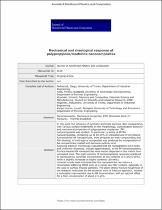JavaScript is disabled for your browser. Some features of this site may not work without it.
- ResearchSpace
- →
- Research Publications/Outputs
- →
- Journal Articles
- →
- View Item
| dc.contributor.author |
Pedrazzoli, D

|
|
| dc.contributor.author |
Tuba, F

|
|
| dc.contributor.author |
Khumalo, VM

|
|
| dc.contributor.author |
Pegoretti, A

|
|
| dc.contributor.author |
Karger-Kocsis, J

|
|
| dc.date.accessioned | 2014-07-18T09:14:10Z | |
| dc.date.available | 2014-07-18T09:14:10Z | |
| dc.date.issued | 2014 | |
| dc.identifier.citation | Pedrazzoli, D, Tuba, F, Khumalo, V.M, Pegoretti, A and Karger-Kocsis, J. 2014. Mechanical and rheological response of polypropylene/boehmite nanocomposites. Journal of Reinforced Plastics and Composites, vol. 33(3), pp 252-265 | en_US |
| dc.identifier.issn | 0731-6844 | |
| dc.identifier.uri | http://jrp.sagepub.com/content/early/2013/10/07/0731684413505787.abstract?patientinform-links=yes&legid=spjrp;0731684413505787v1 | |
| dc.identifier.uri | http://hdl.handle.net/10204/7490 | |
| dc.description | Copyright: 2014 SAGE Publications.This is pre/post print version of the work. The definitive version is published in Journal of Reinforced Plastics and Composites, vol. 33(3), pp 252-265 | en_US |
| dc.description.abstract | In this work the influence of synthetic boehmite alumina (BA) nanoparticles with various surface treatments on the morphology, crystallization behavior and mechanical properties of polypropylene copolymer (PP) nanocomposites was studied. In particular, a series of PP/BA nanocomposites, containing up to 10 wt% of untreated and of octylsilane- functionalized BA nanoparticles, were prepared by melt compounding and film blowing. A third type of composites was produced by incorporation of BA nanoparticles treated with benzene-sulfonic-acid. Scanning electron microscopy indicated that BA nanoparticles were finely and uniformly dispersed, though agglomerated, in the PP nanocomposites. Surface treated BA nanoparticles were better dispersed in the matrix than untreated ones. The melt viscosity of nanocomposites remained unaltered or decreased by nanofiller incorporation at low contents (2.5 and 5 wt%), while it slightly increased at higher contents (10 wt%). Uniaxial tensile tests indicated that the nanoparticles can induce a remarkable stiffening effect even at a rather low filler content, especially in the case of surface treated particles. The plane stress fracture toughness of the material, evaluated by the essential work of fracture approach, showed a noticeable improvement due to BA incorporation, with an optimal effect for a filler concentration of about 2.5 wt%. | en_US |
| dc.language.iso | en | en_US |
| dc.publisher | SAGE Publications | en_US |
| dc.relation.ispartofseries | Workflow;12445 | |
| dc.subject | Reinforced plastics | en_US |
| dc.subject | Nanocomposites | en_US |
| dc.subject | Materials Science | en_US |
| dc.subject | Crystallization behavior | en_US |
| dc.subject | Polypropylene copolymer | en_US |
| dc.subject | PP | en_US |
| dc.subject | PP/BA nanocomposites | en_US |
| dc.subject | BA nanoparticles | en_US |
| dc.title | Mechanical and rheological response of polypropylene/boehmite nanocomposites | en_US |
| dc.type | Article | en_US |
| dc.identifier.apacitation | Pedrazzoli, D., Tuba, F., Khumalo, V., Pegoretti, A., & Karger-Kocsis, J. (2014). Mechanical and rheological response of polypropylene/boehmite nanocomposites. http://hdl.handle.net/10204/7490 | en_ZA |
| dc.identifier.chicagocitation | Pedrazzoli, D, F Tuba, VM Khumalo, A Pegoretti, and J Karger-Kocsis "Mechanical and rheological response of polypropylene/boehmite nanocomposites." (2014) http://hdl.handle.net/10204/7490 | en_ZA |
| dc.identifier.vancouvercitation | Pedrazzoli D, Tuba F, Khumalo V, Pegoretti A, Karger-Kocsis J. Mechanical and rheological response of polypropylene/boehmite nanocomposites. 2014; http://hdl.handle.net/10204/7490. | en_ZA |
| dc.identifier.ris | TY - Article AU - Pedrazzoli, D AU - Tuba, F AU - Khumalo, VM AU - Pegoretti, A AU - Karger-Kocsis, J AB - In this work the influence of synthetic boehmite alumina (BA) nanoparticles with various surface treatments on the morphology, crystallization behavior and mechanical properties of polypropylene copolymer (PP) nanocomposites was studied. In particular, a series of PP/BA nanocomposites, containing up to 10 wt% of untreated and of octylsilane- functionalized BA nanoparticles, were prepared by melt compounding and film blowing. A third type of composites was produced by incorporation of BA nanoparticles treated with benzene-sulfonic-acid. Scanning electron microscopy indicated that BA nanoparticles were finely and uniformly dispersed, though agglomerated, in the PP nanocomposites. Surface treated BA nanoparticles were better dispersed in the matrix than untreated ones. The melt viscosity of nanocomposites remained unaltered or decreased by nanofiller incorporation at low contents (2.5 and 5 wt%), while it slightly increased at higher contents (10 wt%). Uniaxial tensile tests indicated that the nanoparticles can induce a remarkable stiffening effect even at a rather low filler content, especially in the case of surface treated particles. The plane stress fracture toughness of the material, evaluated by the essential work of fracture approach, showed a noticeable improvement due to BA incorporation, with an optimal effect for a filler concentration of about 2.5 wt%. DA - 2014 DB - ResearchSpace DP - CSIR KW - Reinforced plastics KW - Nanocomposites KW - Materials Science KW - Crystallization behavior KW - Polypropylene copolymer KW - PP KW - PP/BA nanocomposites KW - BA nanoparticles LK - https://researchspace.csir.co.za PY - 2014 SM - 0731-6844 T1 - Mechanical and rheological response of polypropylene/boehmite nanocomposites TI - Mechanical and rheological response of polypropylene/boehmite nanocomposites UR - http://hdl.handle.net/10204/7490 ER - | en_ZA |






